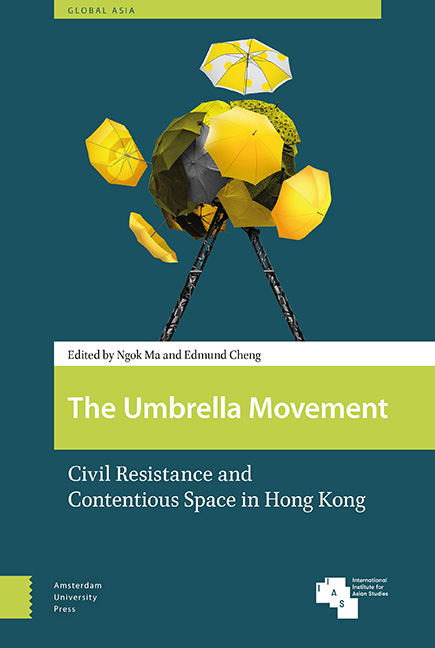Book contents
- Frontmatter
- Contents
- Acknowledgements
- Introduction: Civil Resistance and Contentious Space in Hong Kong
- Part A Trajectory and Contingency
- Part B Repertories and Strategies
- Part C Regime and Public Responses
- Part D Comparative Perspectives
- Appendix: The Umbrella Movement—Chronology of Major Events
- Index
- Publications/Global Asia
5 - Praxis of Cultivating Civic Spontaneity: Aesthetic Intervention in the Umbrella Movement
Published online by Cambridge University Press: 21 November 2020
- Frontmatter
- Contents
- Acknowledgements
- Introduction: Civil Resistance and Contentious Space in Hong Kong
- Part A Trajectory and Contingency
- Part B Repertories and Strategies
- Part C Regime and Public Responses
- Part D Comparative Perspectives
- Appendix: The Umbrella Movement—Chronology of Major Events
- Index
- Publications/Global Asia
Summary
Abstract
This paper aims at conceptualizing the role of co-created artefacts, artistic interventions, aesthetic experience, and the civic-creative learning platform generated in the Umbrella Movement. These aspects of the protest made up what is generally understood as “art,” which we argue acted as a form of civic education during this occupy movement. We explore the triangular relationship between art, politics, and education in the Umbrella Movement through the lens of art theory, highlighting the collaborative and relational aspect of art and the concept of civic spontaneity. As such, we focus on the “endogenous effect” of art, as mass art-making generated opportunities for self-reflection and collaborative learning about civic life that enhanced participants’ understanding of deliberative citizenship.
Keywords: artistic intervention, spontaneity, civic education, endogenous effect of arts, deliberative citizenship
Introduction
Images contain tremendous strength. They are one of the important means of conveying messages and creating alternative epistemic experiences for us to understand ourselves and the world. Thanks to the Internet and the widespread coverage offered by social media, the production and reception of images has become increasingly influential for political debates and social movements. The high turnout for the Umbrella Movement in the fall of 2014 was to a large extent triggered by widespread images of the violent use of pepper spray upon non-violent civic participants. Images of a large group of protesters wearing surgical facemasks and raising their hands against the riot police's tear gas brought Hong Kong into the spotlight of the international media. In his essay on the arts and the Occupy Movement, Mitchell argues that it is the “verbal-visual image that unites revolutionary movements from the Arab Spring to occupy Wall Street” (2012: 11). The Umbrella Movement shares this feature, attracting global attention through a series of shocking images that captured the unexpected evolution of the social movement in Hong Kong. Since the first few days of the movement, the “umbrella” became the iconic object signifying non-violent resistance against regime violence, as well as constituting the rhetoric for naming the occupy movement itself. Protesters’ non-violent display of civil disobedience—by holding umbrellas or posting hands-up gestures in various “confrontation scenes” against the police—was a self-conscious bodily expression that exhibited their resistance. Indeed, these were examples of spontaneous civic participation that required immense courage.
- Type
- Chapter
- Information
- Umbrella MovementCivil Resistance and Contentious Space in Hong Kong, pp. 125 - 148Publisher: Amsterdam University PressPrint publication year: 2019
- 1
- Cited by

